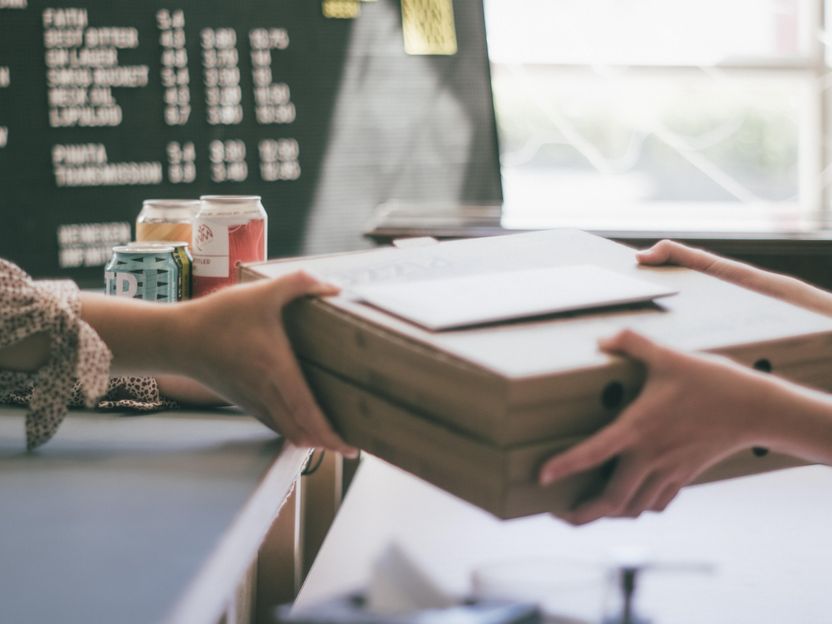Food and drink brands can help US foodservice recovery
Bring restaurant brands into grocery aisles
Advertisement
US consumers are prioritizing restaurants that offer value and familiarity, both of which can be delivered by working with well-known packaged brands.

Photo by Dan Burton on Unsplash
Packaged food and drink brands can lend a helping hand as the US foodservice industry recovers from the challenges brought on by the pandemic. Well-known food and drink brands can provide the value and familiarity that consumers are looking for as they consider returning to restaurants.
Mintel estimates that the total US foodservice industry sales declined 19.5% in 2020, compared to 2019. Mintel predicts that consumer concerns about safety and cautious spending patterns will lead to a slow and unsteady recovery for the US foodservice industry.
Together, restaurants and brands can create co-branded menu items and promotions that inspire more visits. Food and drink companies also can partner with restaurants to offer restaurant-branded products at retail to reach consumers who still prefer to eat at home.
Offer familiarity with co-branded menu items
Packaged food and drink brands can be used as familiar and trustworthy ingredients in restaurant menu items. Indulgent brands can be used to create more fun comfort foods, while flexitarian diners can be courted with items made with emerging plant-based food and drink brands.
Brands can partner with restaurants on co-branded and craveable menu items
Mintel 2021 US Foodservice Trend, ‘Play With Your Food’ predicts that comfort foods and nostalgic ingredients will bring consumers to restaurants in 2021. Menu items that use well-known CPG brands or flavors can deliver more fun and unique twists on familiar comfort foods. Drive-in chain Sonic promoted frozen treats with Oreo cookie dough in March 2021. Later that month, the chain featured seasonal Red Bull slushies in two flavors.
Virtual kitchens provide a new approach for brands
The rising popularity of delivery and takeout-only virtual restaurants, also known as ghost kitchens, presents an opportunity for more retail brands to emphasize their products at foodservice.
In May 2021, PepsiCo reinforced its new “Better With Pepsi” advertising with an online-only food pairing restaurant called Pep’s Place. Consumers who visited its website began their order by selecting a particular cola, including reduced-sugar options and flavored Pepsi.
Menu recommendations were made depending on the type of Pepsi chosen. Regular Pepsi is paired in a “classic combination” with a burger and fries, while buffalo wings are complemented by Pepsi Mango. Orders were available for delivery from Uber Eats, DoorDash and Grubhub.
Plant-based brands can help free-from menu items stand out
Veggie Grill email promotion for tuna melt, May 2021
Restaurants provide curious consumers with venues to try emerging plant-based brands such as Beyond Meat, Oatly oat milk and Good Catch tuna. Healthy diners are particularly interested in a wide variety of plant-based options on menus.
Plant-based has broad appeal, too, as more than two in five US adults who have visited a QSR expect all fast-food restaurants to offer a plant-based food option by now.
Increase visits by promoting more occasions
Restaurants can work with brand partners to create menu items and promotions that encourage consumers to return to pre-pandemic dining patterns. Co-branded promotions and menu items can inspire more on-the-go breakfast orders, work-day lunches or afternoon snacks.
Encourage consumers to include restaurant stops in their recovery routines
Restaurants can partner with well-known food and drink brands to entice consumers to include foodservice orders in their recovery routines. Stops for coffee, picking up restaurant food for a work-day lunch or ordering dinner on the way home can be part of the return to normal that more than half of US adults surveyed April 29-May 13, 2021 are expecting for summer 2021.
Make ordering lunch more enticing with branded add-ons
Packaged brands that offer drink pairings, sides and co-branded menu items can help encourage consumers to order lunch from restaurants rather than making lunch at home.
According to Mintel research on the future of foodservice, more than one-quarter of US adults who have ordered from restaurants are interested in ordering lunch for home delivery. Interest in lunch delivery rises to 39% of ages 18-24 and 36% of ages 25-34.
These younger consumers are a key audience for email, text or social media promotions that inspire them to act fast to get a certain deal. Branded drinks, sides and desserts can be promoted as add-ons to get free delivery or to stock up for a future meal, such as KFC‘s “Enough Food For Today and Tomorrow” messaging.
Bring restaurant brands into grocery aisles
Packaged food and drink companies can help restaurants use grocery offerings to reach people who are still not comfortable dining out. The quality reputation that restaurant brands enjoy will help prepared meals, sauces and other packaged versions of signature menu items stand out on retail shelves.
Engage hesitant diners with restaurant-branded products at retail
Although the recovery is moving quickly in the US, a portion of consumers are not yet comfortable returning to restaurants. As of April 29-May 13, 2021, more than a quarter of US adults were not comfortable dining indoors and nearly half of US adults aged 21+ were not comfortable drinking at an indoor bar.
In addition to takeaway and delivery, restaurants can reach reluctant in-person diners at grocery retailers. In 2020, many restaurants offered prepared meals, meal kits and other items in order to reach consumers. Food and drink companies can help restaurants more easily make retail offerings permanent.
A restaurant’s trust and quality reputation will help branded items stand out on grocery shelves
Restaurant brands can follow early retail adopters like White Castle, which has sold its sliders in grocery stores for more than a decade. Packaged food and drink companies can help restaurants create, produce and market signature items at retail. The partnerships capitalize on consumers’ familiarity and trust of the restaurant brand. The quality perception also helps products stand out on shelves and command premium prices.
What Mintel thinks
The trust and familiarity of packaged food and drink brands are assets for foodservice to leverage to help encourage people to return to pre-pandemic dining patterns. Restaurants can appeal to consumers who are ready to dine out with co-branded menu items and promotions that encourage lunch, breakfast or coffee visits. To appeal to consumers who are still more comfortable eating at home, restaurant brands can partner with food and drink companies to sell packaged versions of their signature items or flavors at grocery stores.






























































